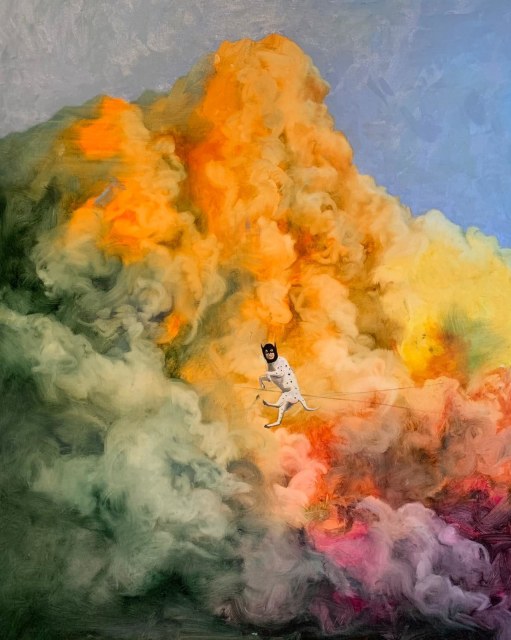Nour Malas
Philip Mueller
Edgar Orlaineta
Jana Ghalayini
CARBON 12 is pleased to present a booth with works of Syrian-Canadian artist Nour Malas, Austrian artist Philip Mueller, Mexican artist Edgar Orlaineta, and Saudi artist Jana Ghalayini. Delving into each of their practices, and the exploration of the unknown, the works manipulate our familiar surroundings in a contemporary manner. Varying from the most concrete forms into the haziness of the absurd, each artist allow their audiences to explore their inner most intimate thoughts and reflections.
Through his practice, Edgar Orlaineta gives ordinary design elements a new dimension by inscribing them into a more historically relevant environment. Drawing inspiration from pop culture, historical events, and post-war design, he aims to portray a consumerist and wasteful world, while challenging the idea of the seriousness of art. Denying the original functionality of those represented elements, Orlaineta gives his objects a new historical and cult value, by pushing their boundaries.
In a world where dream and reality intertwine, Nour Malas guides viewers through the confined spaces of her mind. With much less definition to her lines and a larger focus on a rich color palette, Malas creates a setting where consciousness and subconsciousness simultaneously rule. She transcribes an emotive vocabulary by adorning her works with animal figures, living beings, and at times vehicles. The poetry that comes through her representations describes what she calls ‘fleeting moments’. Line and color, time and space, encounters and conflicts, merge through her contrasting use of color, and show an undefined spiritual depth to her rather visual works.
Bridging these two seemingly distinct practices through his new paintings depicting clouds and helmet figures, Philip Mueller highlights the meeting point between the unknown divine and the familiar human world, as well as the absurd, much like Malas’s works that also merge together these distinct dimensions. Both artists delve into their feelings of longing and desire, creating a space of their own that stems from the natural world. Philip Mueller points out how nature is never devoid of human touch, joining on Orlaineta’s idea behind the manipulation of design objects, further questioning their functionality, and historical value, and further relating to Ghalayini’s works in which she incorporates human made elements into a rather traditional practice: weaving. Symbolism having a large role in Mueller’s works, his ‘Knights of Pothos’ or ‘helmet figure’ paintings are no different. Hope emanates from these disguised figures adorned by a multitude of flora and fauna, the armor being a symbol of protection and war contrasting with the softness and lightness brought by the myriad of floral elements adorning its surroundings.
Jana Ghalayini’s textile works weave together Mueller’s contemporary manipulation of the traditional to Malas’s blurred yet concrete depictions, and Orlaineta’s use of craftsmanship as a core to both their practices. Ghalayini delves into her Palestinian heritage, exploring the practice of weaving. Within her experimentation with fabrics and dyes, she manages to meld together linearity and fluidity, creating a soft visual that leads the viewer’s eye to follow the distinct threads running along her works. Just as Mueller melds together his classical painting technic with the use of contemporary details, Jana Ghalayini uses weaving and combines it with present day elements, such as beads, metal rings, and fragments of printed paper. Ghalayini focuses on the use of a traditional loom but also experiments with dyes and other more contemporary machinery, like the scanner, with which she creates different dimensions within her patterned textiles, much like Orlaineta who experiments with historical and contemporary tools, such as the lathe, to bring his works to life. By manipulating her media, Ghalayini manages to keep the raw aspect of the material, while inscribing it deeper into the contemporary world and reflecting on her origins.
Imaginary lines are born within the defined and geometrical shapes Edgar Orlaineta carves into his preferred medium of wood. Orlaineta’s manipulation of the material and its decontextualization align with Mueller’s conviction that nature is always an object of development rather than a raw display of wilderness. These lines continue on within the woven threads running through Jana Ghalayini’s works as she maneuvers them into a more fluid visual. While in Malas’s practice these lines fade into the haziness of the brush strokes adorning her paintings. The ambivalence created between the blurry and the concrete unites all four artists. Ghalayini’s use of thread evokes softness in opposition to the harshness brough by the external elements she incorporates within her rather airy works, aligning perfectly with Nour Mallas’s use of contrasting figurative and foggy depictions, Mueller’s opposing floral and armor elements, and Orlaineta’s meshing of both the geometrical aspect of the wood and the fluidity of the paint applied onto his works. Mallas also complements Mueller’s practice by emphasizing the coexistence of the divine and the human realm. Together, they reflect on the undefined lines that weave the familiar with the unknown.



